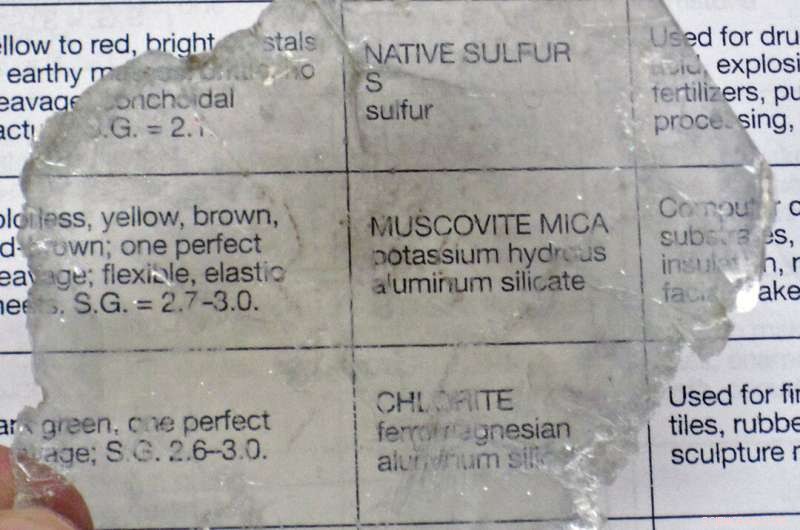
Muskovitglimmer (MuM) är ett skiktat mineral som vanligtvis används som isolator. I en ny studie observerade forskare att MuM, när det tunnas ner till några molekyllager, fungerar mer som en halvledare med en tjockleksberoende konduktivitet. Kredit:James St. John
Glimmer, en välkänd isolator, har visat sig bete sig som en halvledare när den tunnas ned till några molekylära lager
Muskovitglimmer (MuM) är ett mycket stabilt mineral som vanligtvis används som isolator. De elektriska egenskaperna hos enskikts- och fåskikts MuM är dock inte väl förstått. Nu rapporterar och förklarar en grupp forskare från Japan och Indien ovanligt hög ledningsförmåga i MuM-flingor som bara är några molekylskikt tjocka. Deras resultat kan öppna dörrar för utvecklingen av tvådimensionella elektroniska enheter som är robusta mot tuffa miljöer.
År 2004 använde forskare från University of Manchester tejp för att dra ark av enstaka kolatomer bort från grafit för att göra grafen - ett material som är 1000 gånger tunnare än människohår men ändå starkare än stål. Denna banbrytande exfolieringsteknik banade vägen för utvecklingen av ett brett utbud av tvådimensionella material med distinkta elektriska och fysiska egenskaper för nästa generations elektroniska enheter.
Ett sådant material av intresse har varit muskovit glimmer (MuM). Dessa mineraler har den allmänna formeln KAl2 (AlSi3 O10 ) (F, OH)2 och har en skiktad struktur bestående av aluminium (Al), kalium (K) och kisel (Si). Liksom grafen har MuM fått uppmärksamhet som ett ultraplatt substrat för att bygga flexibla elektroniska enheter. Till skillnad från grafen är MuM en isolator.
De elektriska egenskaperna hos MuM är dock inte helt klara. Speciellt är egenskaperna hos tjocka MuMs med enkla och fåmolekylära skikt inte klart förstått. Detta beror på att i alla studier som hittills har undersökt de elektriska egenskaperna hos MuM har konduktiviteten dominerats av ett kvantfenomen som kallas "tunneling". Detta har gjort det svårt att förstå den ledande naturen hos tunt MuM.
In a recent study published in the journal Physical Review Applied , Professor Muralidhar Miryala from Shibaura Institute of Technology (SIT), Japan, along with Professors M. S. Ramachandra Rao, Ananth Krishnan and Mr. Ankit Arora, a Ph.D. student, from Indian Institute of Technology Madras, India, have now observed a semiconducting behavior in thin MuM flakes, characterized by an electrical conductivity that is 1000 times larger than that of thick MuM. "Mica has been one of the most popular electrical insulators used in industries for decades. However, this semiconductor-like behavior has not been reported earlier," says Prof. Miryala.
In their study, the researchers exfoliated thin MuM flakes of varying thickness onto silicon (SiO2 /Si) substrates and, to avoid tunneling, maintained a separation of 1 µm between the contact electrodes. On measuring the electrical conductivity, they noticed that the transition to a conducting state occurred gradually as the flakes were thinned down to fewer layers. They found that for MuM flakes below 20 nm, the current depended on the thickness, becoming 1000 times larger for a 10 nm thick MuM (5 layers thick) compared to that in 20 nm MuM.
To make sense of this result, the researchers fitted the experimental conductivity data to a theoretical model called the "hopping conduction model," which suggested that the observed conductance is due to an increase in the conduction band carrier density with the reduction in thickness. Put simply, as the thickness of MuM flakes is reduced, the energy required to move electrons from the solid bulk to the surface decreases, allowing the electrons easier passage into the "conduction band," where they can freely move to conduct electricity. As to why the carrier density increases, the researchers attributed it to the effects of surface doping (impurity addition) contributions from K + ions and relaxation of the MuM crystal structure.
The significance of this finding is that thin exfoliated sheets of MuM have a band structure similar to that of wide bandgap semiconductors. This, combined with its exceptional chemical stability, makes thin MuM flakes an ideal material for two-dimensional electronic devices that are both flexible and durable. "MuM is known for its exceptional stability in harsh environments such as those characterized by high temperatures, pressures, and electrical stress. The semiconductor-like behavior observed in our study indicates that MuM has the potential to pave the way for the development of robust electronics," says Prof. Miryala. + Explore further